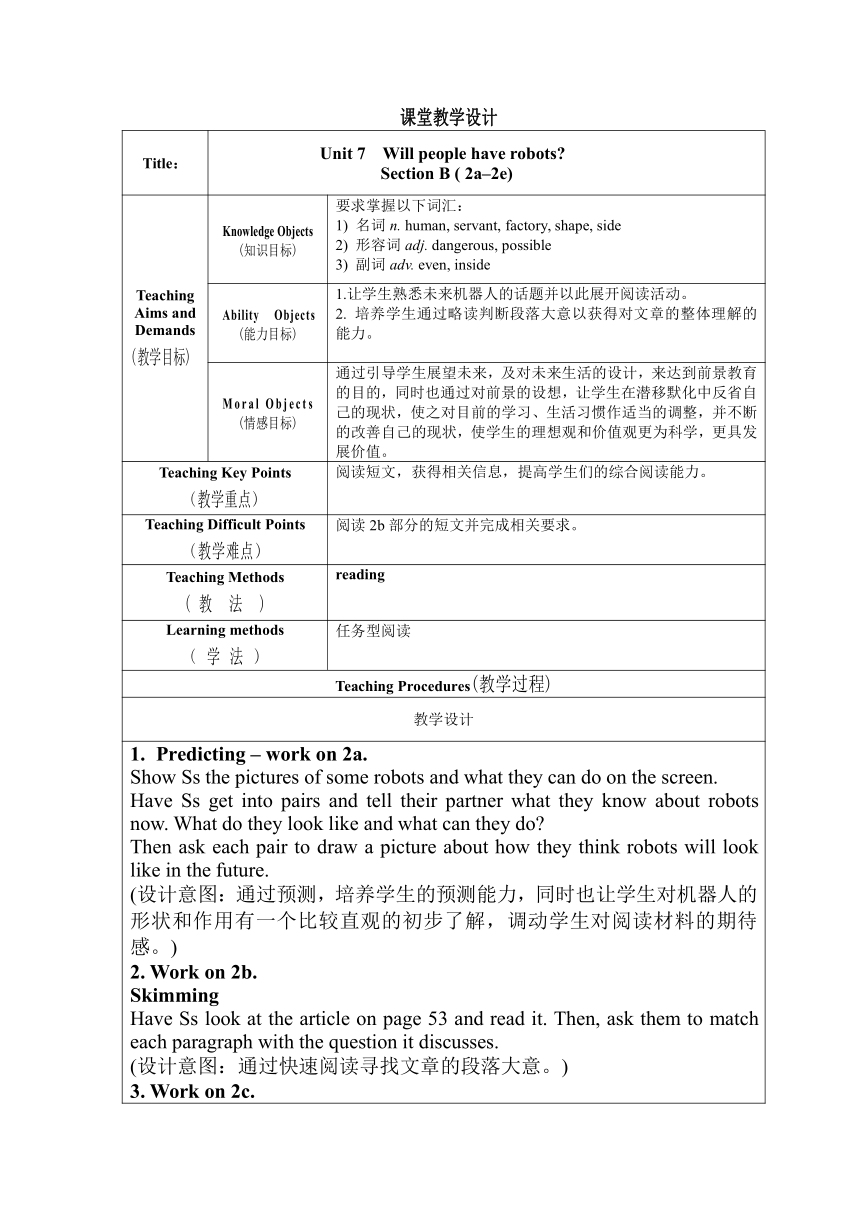Will people have robots?Section B 2a-2e 教案 人教版八年级上册英语(表格式)
文档属性
| 名称 | Will people have robots?Section B 2a-2e 教案 人教版八年级上册英语(表格式) |  | |
| 格式 | docx | ||
| 文件大小 | 20.9KB | ||
| 资源类型 | 教案 | ||
| 版本资源 | 人教新目标(Go for it)版 | ||
| 科目 | 英语 | ||
| 更新时间 | 2022-09-05 08:28:21 | ||
图片预览

文档简介
课堂教学设计
Title: Unit 7 Will people have robots Section B ( 2a–2e)
Teaching Aims and Demands (教学目标) Knowledge Objects (知识目标) 要求掌握以下词汇: 1) 名词n. human, servant, factory, shape, side 2) 形容词adj. dangerous, possible 3) 副词adv. even, inside
Ability Objects (能力目标) 1.让学生熟悉未来机器人的话题并以此展开阅读活动。 2. 培养学生通过略读判断段落大意以获得对文章的整体理解的能力。
Moral Objects (情感目标) 通过引导学生展望未来,及对未来生活的设计,来达到前景教育的目的,同时也通过对前景的设想,让学生在潜移默化中反省自己的现状,使之对目前的学习、生活习惯作适当的调整,并不断的改善自己的现状,使学生的理想观和价值观更为科学,更具发展价值。
Teaching Key Points (教学重点) 阅读短文,获得相关信息,提高学生们的综合阅读能力。
Teaching Difficult Points (教学难点) 阅读2b部分的短文并完成相关要求。
Teaching Methods (教法) reading
Learning methods (学法) 任务型阅读
Teaching Procedures(教学过程)
教学设计
Predicting – work on 2a. Show Ss the pictures of some robots and what they can do on the screen. Have Ss get into pairs and tell their partner what they know about robots now. What do they look like and what can they do Then ask each pair to draw a picture about how they think robots will look like in the future. (设计意图:通过预测,培养学生的预测能力,同时也让学生对机器人的形状和作用有一个比较直观的初步了解,调动学生对阅读材料的期待感。) 2. Work on 2b. Skimming Have Ss look at the article on page 53 and read it. Then, ask them to match each paragraph with the question it discusses. (设计意图:通过快速阅读寻找文章的段落大意。) 3. Work on 2c. Scanning Have Ss read the article again quickly. Then have them work in pairs on 2c and complete the sentences about what robots can do now. (以两人一组为单位询问组内成员的情况。此环节不仅可以增进同学间对计划内容的了解,也有助于对计划实施情况的了解。) 4. Work on 2d. Have Ss read the paragraph in 2d first. Then, ask them to fill in the blanks with words from the article in 2b. Walk around the class, and offer help when necessary. (设计意图:这个环节是对阅读语篇的缩写,通过填词帮助学生转换文章信息,加深对文章的理解。) 5. Work on 2e. Have Ss get into pairs and discuss the questions in 2e. T: What kinds of animals might robots look like in the future What do you think these robots will be able to do Write your ideas and discuss them with your partner. (设计意图:这是一个读后讨论拓展活动,让学生在课文内容的基础上发挥自己的想象力,对机器人的未来发展情况进行预测,并与同伴分享。) 6. Homework Oral: Read the paragraph in 2d aloud. Written: Write a passage about the kind of robot you want to have in the future and why.
Title: Unit 7 Will people have robots Section B ( 2a–2e)
Teaching Aims and Demands (教学目标) Knowledge Objects (知识目标) 要求掌握以下词汇: 1) 名词n. human, servant, factory, shape, side 2) 形容词adj. dangerous, possible 3) 副词adv. even, inside
Ability Objects (能力目标) 1.让学生熟悉未来机器人的话题并以此展开阅读活动。 2. 培养学生通过略读判断段落大意以获得对文章的整体理解的能力。
Moral Objects (情感目标) 通过引导学生展望未来,及对未来生活的设计,来达到前景教育的目的,同时也通过对前景的设想,让学生在潜移默化中反省自己的现状,使之对目前的学习、生活习惯作适当的调整,并不断的改善自己的现状,使学生的理想观和价值观更为科学,更具发展价值。
Teaching Key Points (教学重点) 阅读短文,获得相关信息,提高学生们的综合阅读能力。
Teaching Difficult Points (教学难点) 阅读2b部分的短文并完成相关要求。
Teaching Methods (教法) reading
Learning methods (学法) 任务型阅读
Teaching Procedures(教学过程)
教学设计
Predicting – work on 2a. Show Ss the pictures of some robots and what they can do on the screen. Have Ss get into pairs and tell their partner what they know about robots now. What do they look like and what can they do Then ask each pair to draw a picture about how they think robots will look like in the future. (设计意图:通过预测,培养学生的预测能力,同时也让学生对机器人的形状和作用有一个比较直观的初步了解,调动学生对阅读材料的期待感。) 2. Work on 2b. Skimming Have Ss look at the article on page 53 and read it. Then, ask them to match each paragraph with the question it discusses. (设计意图:通过快速阅读寻找文章的段落大意。) 3. Work on 2c. Scanning Have Ss read the article again quickly. Then have them work in pairs on 2c and complete the sentences about what robots can do now. (以两人一组为单位询问组内成员的情况。此环节不仅可以增进同学间对计划内容的了解,也有助于对计划实施情况的了解。) 4. Work on 2d. Have Ss read the paragraph in 2d first. Then, ask them to fill in the blanks with words from the article in 2b. Walk around the class, and offer help when necessary. (设计意图:这个环节是对阅读语篇的缩写,通过填词帮助学生转换文章信息,加深对文章的理解。) 5. Work on 2e. Have Ss get into pairs and discuss the questions in 2e. T: What kinds of animals might robots look like in the future What do you think these robots will be able to do Write your ideas and discuss them with your partner. (设计意图:这是一个读后讨论拓展活动,让学生在课文内容的基础上发挥自己的想象力,对机器人的未来发展情况进行预测,并与同伴分享。) 6. Homework Oral: Read the paragraph in 2d aloud. Written: Write a passage about the kind of robot you want to have in the future and why.
同课章节目录
- Unit 1 Where did you go on vacation?
- Section A
- Section B
- Unit 2 How often do you exercise?
- Section A
- Section B
- Unit 3 I'm more outgoing than my sister.
- Section A
- Section B
- Unit 4 What's the best movie theater?
- Section A
- Section B
- Unit 5 Do you want to watch a game show?
- Section A
- Section B
- Unit 6 I'm going to study computer science.
- Section A
- Section B
- Unit 7 Will people have robots?
- Section A
- Section B
- Unit 8 How do you make a banana milk shake?
- Section A
- Section B
- Unit 9 Can you come to my party?
- Section A
- Section B
- Unit 10 If you go to the party, you'll have a grea
- Section A
- Section B
